Imagine gliding past sun-drenched vineyards, ancient stone bridges and fairytale villages – all from the comfort of a floating “hotel”. A boat holiday on the Canal du Midi is not just a trip – it’s a way of life. Whether you’re a beginner or an experienced skipper, this UNESCO World Heritage canal in the south of France offers peace, charm and a touch of adventure.
In a week, you can cruise past olive groves, medieval castles and market villages. No boating license is required, just a little curiosity and an open mind. This guide will walk you through it all: when to go, how the lock gates work, which villages to stop at and how to make your trip even more exciting with a bike ride or wine tasting.
Let’s go – let’s go!
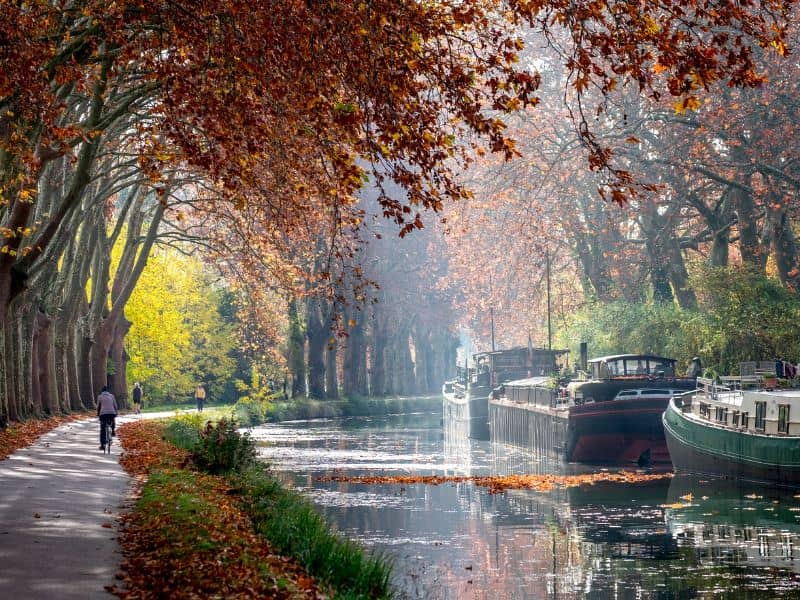
This article will cover:
- What Is the Canal du Midi?
- Why choose a boating holiday here?
- How canal cruising works
- Top tips for first-time boaters
- Must-see attractions along the way
- Packing list and essentials
What Is the Canal du Midi?
The Canal du Midi is a 17th-century engineering marvel that connects the Garonne River in Toulouse to the Mediterranean Sea for over 240 kilometers. It was designed by Pierre-Paul Riquet to avoid the long and dangerous sea route around Spain. Today, it is one of the most beautiful destinations for slow travel and water tourism. It was declared a UNESCO World Heritage Site in 1996. The route winds past picturesque vineyards, sleepy villages and beautiful towns such as Carcassonne and Béziers. Along the way, you’ll pass through hand-operated lock gates, arched stone bridges and even Europe’s first navigable tunnel, the Malpas Tunnel.
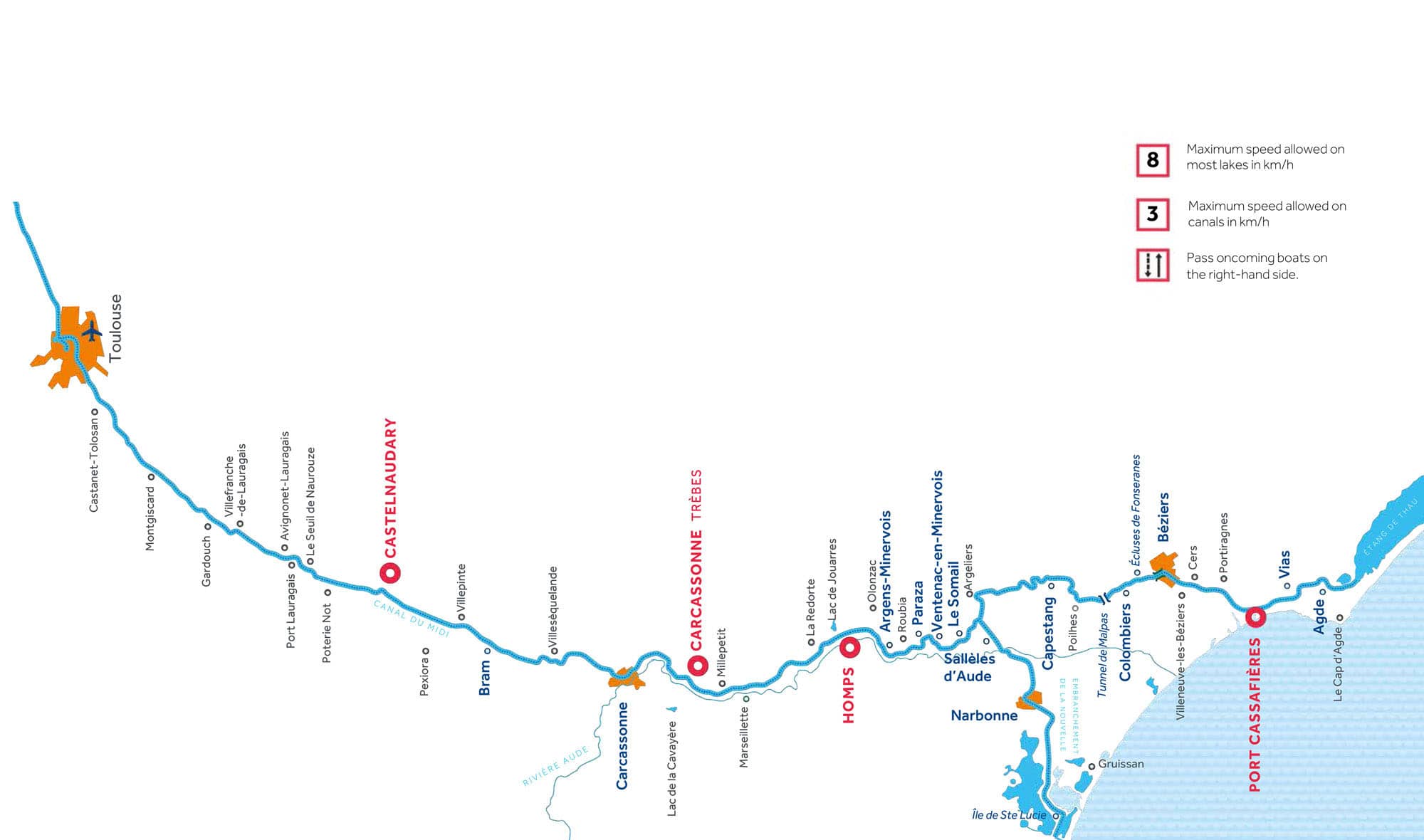
Why choose a boating holiday here?
There are many canals in Europe – but the Canal du Midi is simply different. This place is not just a route, it is a lifestyle. One moment you are moored under a medieval castle, the next you are sipping local wine in the shade of a plane tree. The canal is perfectly prepared to welcome boat tourists: with well-equipped bases in the towns of Castelnaudary, Homps or Port Cassafières, helpful lockkeepers and regular moorings. You will find small shops, bakeries, local markets everywhere – and of course a bottle of local wine will always be at hand.
How canal cruising works
It is surprisingly easy, even for beginners. No boatman’s license is required, and rental companies provide a short training. The boats are varied: the smaller ones are ideal for couples or families, the larger ones even serve as floating holiday homes, with a sun terrace, barbecue, Wi-Fi. The lock gates must be used slowly and patiently – sometimes automatically, sometimes with the help of a lockkeeper. The speed of the boat is about 7 km/h, so you have plenty of time to take photos, have a picnic or just enjoy the silence. Mooring is allowed almost anywhere where you can safely reach the shore.
What is the best month to sail the Canal du Midi?
It depends on what you are looking for. If you want warmth and bustle, then it is worth coming between May and September. In July and August, there are festivals, markets and lively villages – but this is also when the tourists are the most numerous. If you are looking for peace, then the end of April, beginning of June or mid-September are ideal. The weather is still good, but there are fewer people. And in October, the colors of nature deepen, and the canal invites you to quiet contemplation – perfect for photographers and couples.
Which boat should I choose?
The style and comfort of the boats vary widely. A small Horizon 1 might be perfect for couples, while a spacious Vision with a deck barbecue is ideal for larger groups. Think about what you want: air conditioning? A sunny roof deck? A bike rack? You can choose according to your budget – but the sunsets, wine and waterfront are the same on every ship. Canal boat rental on the Canal du Midi
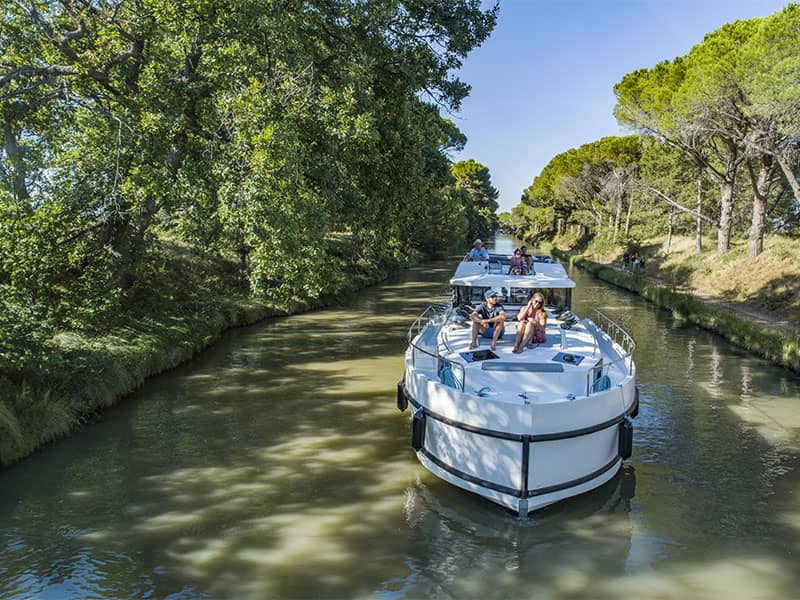
Recommended itinerary for 5 days
If you’re short on time, try the Homps – Trèbes – Carcassonne route. You can pass through picturesque villages (Argens-Minervois, La Redorte) and spend an afternoon in the world-famous fortress of Carcassonne. Another option: Castelnaudary – Bram – Carcassonne. Here you should try the famous cassoulet and visit the Cugarel windmill or the St. Michel church.
Recommended route for 7 days
A full week will take you almost anywhere. The classic route: Carcassonne – Port Cassafières. Along the way, you will find Trèbes, the fascinating Le Somail, the famous Fonseranes lock system, and finally the sandy beach. Alternative: Castelnaudary – Homps. This route takes you through villages, wineries and olive groves. 3-5 hours of sailing per day is more than enough, and there is also time for a wine tour or market visit.
Top tips for first-time boaters
Don’t rush – this holiday is all about slow travel. Practice lock handling with your team before you set off. It’s good if everyone knows what their job is: who’s steering, who’s mooring, who’s waving to pedestrians. Shop in advance. There are well-equipped shops in larger towns (Carcassonne, Capestang), but there are fewer options in smaller villages. For your safety: have a life jacket on hand, always keep to the right to avoid oncoming boats, and don’t stop near locks or bridges.
Locks and distances
Locks are part of the journey – sometimes a challenge, sometimes fun. Some days you’ll have 3-4 locks, other days none. For example, after the Argens lock there are none for 54 km – this is the famous “big mirror” section. The speed limit is approx. The speed is 7.5 km/h and the lock time is around 12 minutes – so it is worth planning ahead every day. Especially at the Fonseranes lock system, where there are fixed times, you need to pay special attention.
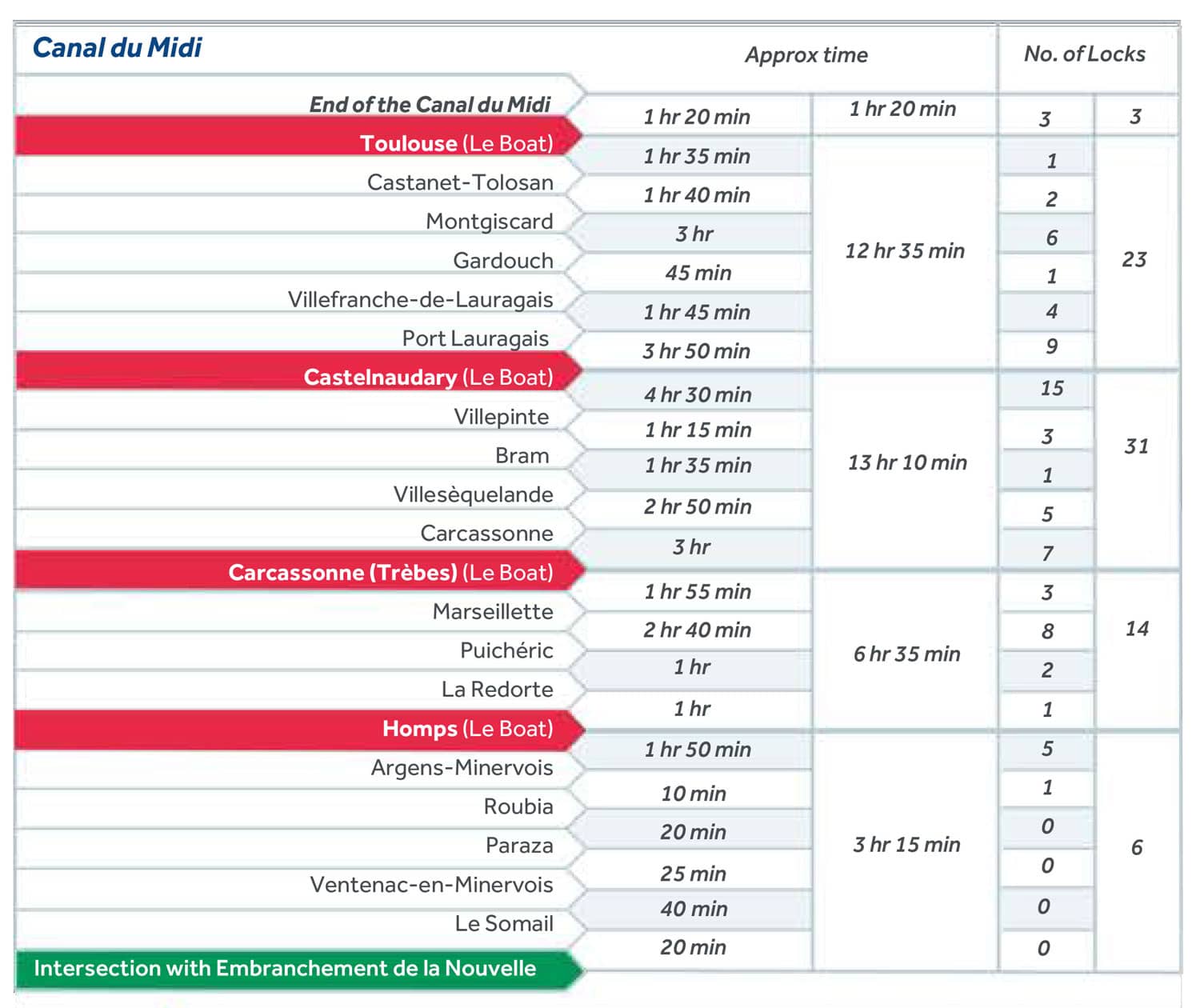
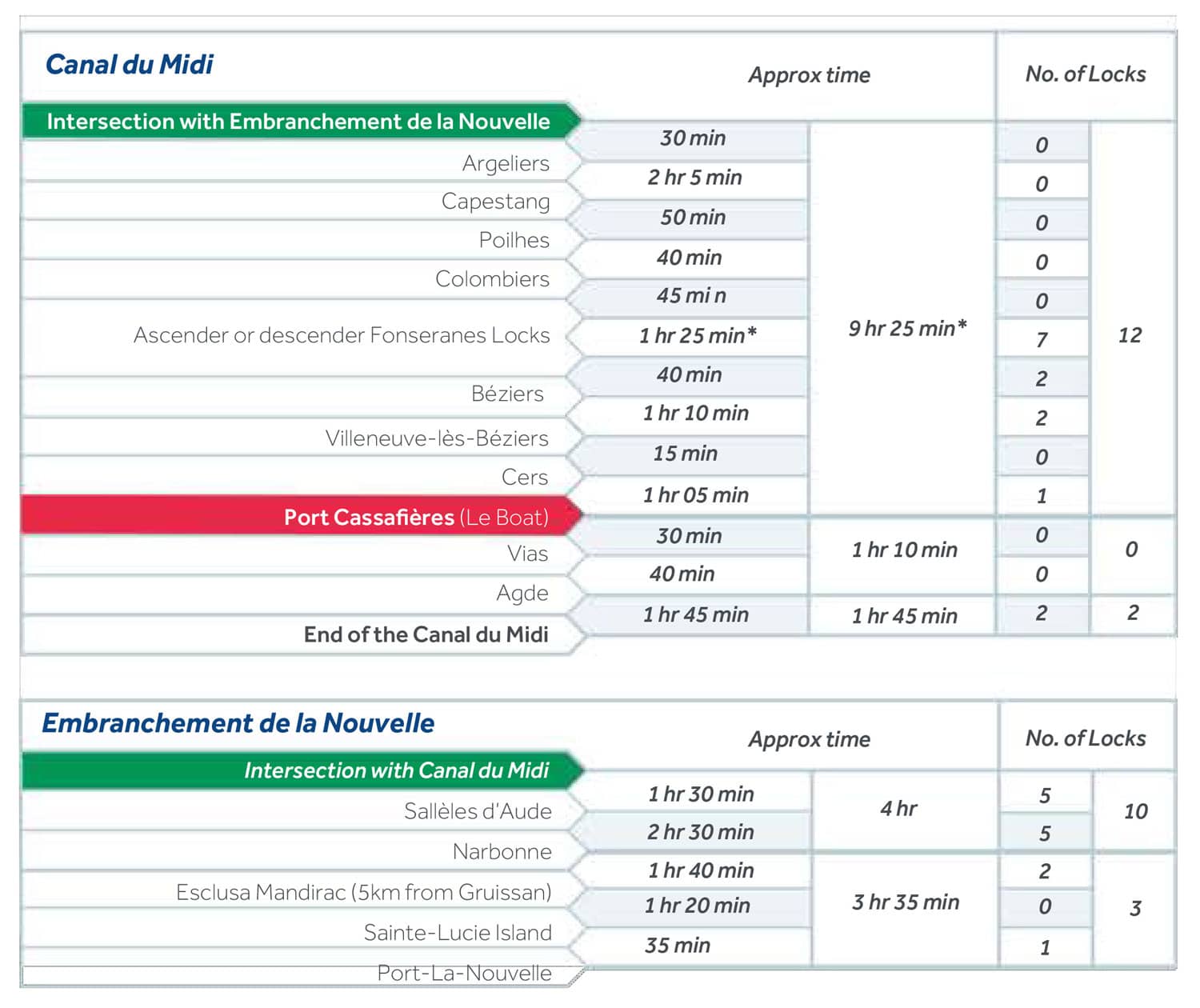
Must-see attractions along the way
A The list is almost endless: the fairytale castle of Carcassonne, the beach of Homps, the book barge of Le Somail, the viewpoint of Argens-Minervois, the wine tastings of Paraza, or the medieval cathedral of Béziers. If you reach the sea, you can end your cruise with a cool swim at the golden sandy beach of Portiragnes-Plage.
Boat + bike: The perfect combination
If you can’t sit for long, rent a bike! The canal bank is flat, shady and perfect for cycling. You can even attach your bike to a boat or go ahead to the next village for breakfast. The Homps – Minerve tour is 12 km – but it’s worth every minute.
This is how to fit cycling into your itinerary
1-2 hours of cycling a day can be refreshing. It’s also worth using it for shopping, viewing points, and markets – for example, the Tuesday market in Olonzac. In the Sallèles d’Aude area, even Narbonne is easily accessible with a short ride. And if you want to get some exercise after a hearty boat lunch, there’s nothing better.
Packing list and essentials
- Pack lightly but smartly. What will definitely come in handy:
- Soft suitcase (easy to pack)
- Sun hat, sunglasses, sunscreen
- Layered clothing (it can be cool in the mornings)
- Mosquito repellent
- Flip-flops + comfortable shoes
- Corkscrew. Seriously.
- Charger and adapter
- Snacks, wine, picnic supplies
- Water bottle – water tank refills are limited
And the most important thing: Good mood and flexibility – with these, every sailing trip will be an experience.